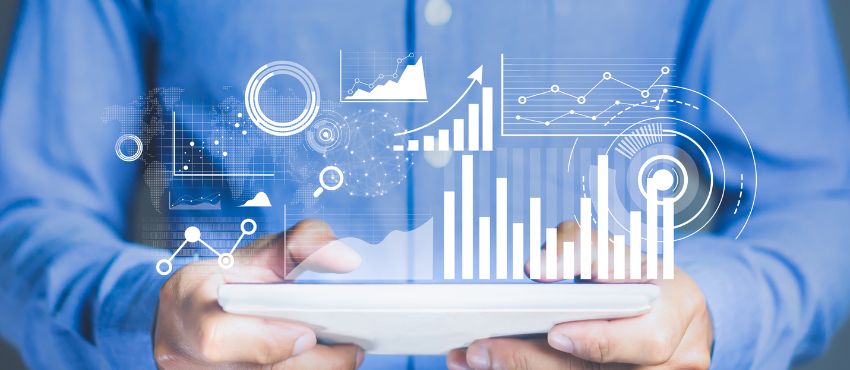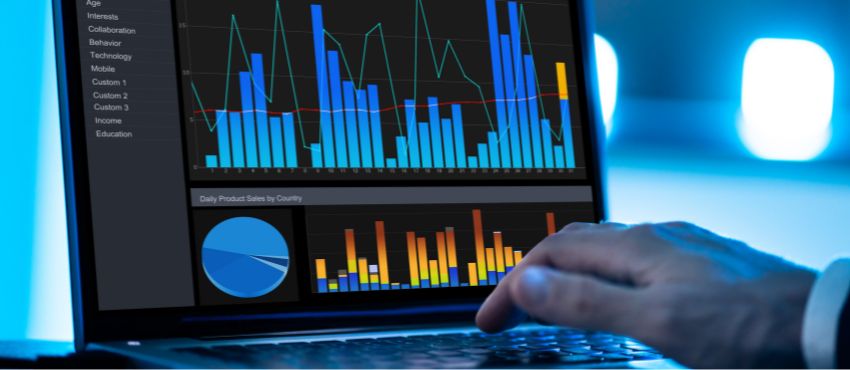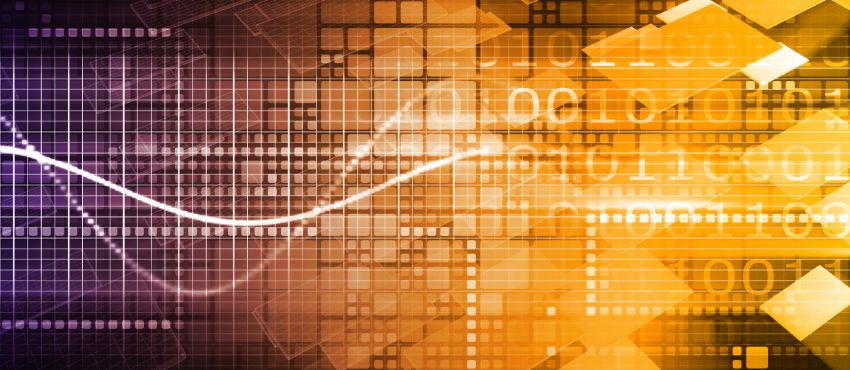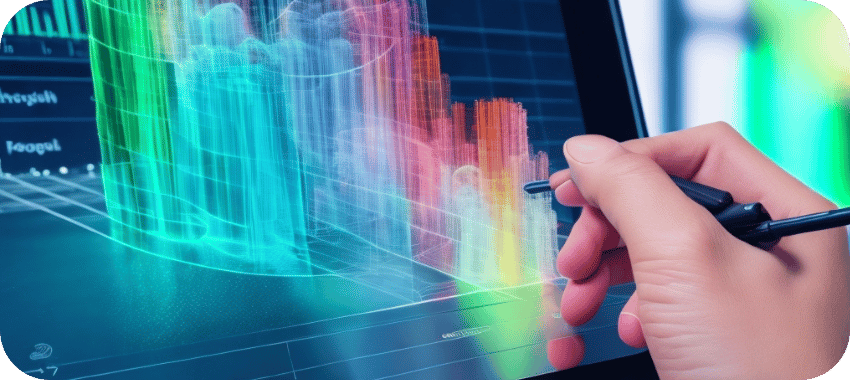The 17 Benefits of Predictive Analytics
In the digital age, data is the new gold. Every interaction, transaction, and engagement generates data that businesses can leverage to drive growth and success. The key to unlocking this potential lies in predictive analytics. This powerful tool uses historical data to predict future events, enabling businesses to make informed decisions and stay ahead of the competition. Today, the importance of predictive analytics cannot be overstated. It’s not just a nice-to-have—it’s a must-have.

What is Predictive Analytics?
Predictive analytics is a form of advanced analytics that uses data, statistical algorithms, and machine learning techniques to predict future outcomes based on historical data. Think of it as a high-tech crystal ball that businesses can use to forecast what will happen in the future. The process begins with data. Predictive analytics algorithms sift through vast amounts of data to identify patterns and trends. These patterns and trends are then used to create a predictive model that can forecast future outcomes.
However, predictive analytics is more than just data and algorithms. It also involves data mining, analytical, and predictive modeling techniques. Data mining explores and analyzes large amounts of data to discover meaningful patterns and rules. Analytical modeling creates a mathematical model that represents a real-world situation. Predictive modeling uses these models to predict future outcomes.
In essence, predictive analytics brings together data, technology, and business strategy to make accurate predictions about the future. It’s a powerful tool that can give businesses a competitive edge in today’s data-driven world.

17 Benefits of Predictive Analytics
Predictive analytics is transforming how businesses operate, offering unparalleled insights into customer behavior, market trends, and operational efficiency. By leveraging data, predictive analytics enables businesses to anticipate outcomes and take proactive measures, giving them a competitive edge in an ever-changing marketplace. In this post, we’ll explore the benefits of predictive analytics, with a focus on how these tools can enhance decision-making, improve customer segmentation, and drive smarter pricing strategies for manufacturing rep firms.
1. Competitive Advantage with Predictive Analytics
In the cut-throat world of business, predictive analytics can be the secret weapon that gives a company the edge over its competitors. For instance, Amazon uses predictive analytics to recommend products to its customers based on their browsing and purchasing history. This personalized shopping experience not only increases customer satisfaction but also boosts sales, giving Amazon a significant advantage in the e-commerce space.
2. Quoting and the Sales Process
Predictive analytics can revolutionize the quoting and sales process, driving efficiency and profitability. By analyzing historical sales data and customer behavior, businesses can accurately forecast sales, optimize pricing, and create competitive quotes. This data-driven approach allows for tailored strategies that meet specific customer needs, increasing the likelihood of successful sales. Furthermore, predictive analytics can enhance customer relationship management by identifying customers at risk of churn, enabling proactive measures to improve customer retention. In essence, predictive analytics streamlines the sales process, prioritizes promising leads, and fosters customer satisfaction and loyalty.
3. Finding New Revenue Opportunities
Predictive analytics can also help businesses identify new revenue opportunities. By analyzing customer behavior, market trends, and economic indicators, businesses can predict future demand for their products or services and identify potential new markets. For example, Netflix uses predictive analytics to identify viewing patterns and preferences, which helps them decide which new shows to produce, leading to increased viewership and revenue.
4. Improving Fraud Detection
Fraud is a significant concern for many businesses, particularly in the financial sector. Predictive analytics can help detect fraudulent activity by identifying patterns and anomalies that may indicate fraudulent behavior. For example, credit card companies use predictive analytics to identify unusual spending patterns, enabling them to detect and prevent fraud quickly.
5. Optimizing Processes and Performance
Predictive analytics can help businesses optimize their processes and improve performance. By analyzing operational data, businesses can identify inefficiencies and bottlenecks, allowing them to streamline their processes and improve productivity. For instance, airlines use predictive analytics to optimize flight schedules and routes, reducing delays and improving customer service.
6. Increasing Asset Utilization
Predictive analytics can also help businesses increase asset utilization. By predicting when equipment is likely to fail, businesses can perform maintenance before a breakdown occurs, reducing downtime and improving asset utilization. For example, manufacturing companies use predictive analytics to predict equipment failures, allowing them to schedule maintenance proactively and avoid costly production downtime.
7. Improving Production Capacity and Quality
Predictive analytics can help businesses improve their production capacity and product quality. By analyzing production data, businesses can identify factors that affect production capacity and product quality, enabling them to make necessary adjustments. For example, food and beverage companies use predictive analytics to monitor and control production processes, ensuring consistent product quality and reducing waste.
8. Improving Collaboration and Control
Predictive analytics can improve collaboration and control within a business. By providing accurate forecasts and actionable insights, predictive analytics enables different departments within a business to work together more effectively and make informed decisions. For example, sales and marketing teams can use predictive analytics to coordinate their efforts and target the right customers at the right time.
9. Reducing Risks
Predictive analytics can help businesses reduce risks. By predicting potential problems and issues, businesses can take proactive measures to mitigate these risks. For example, insurance companies use predictive analytics to assess the risk associated with insuring a particular individual or property, allowing them to set premiums accurately and manage their risk effectively.
10. Understanding Customer Needs
Understanding customer needs is crucial for business success, and predictive analytics can provide valuable insights into what customers want and need. By analyzing customer data, businesses can identify trends and patterns in customer behavior, enabling them to tailor their products and services to meet customer needs. For example, telecom companies use predictive analytics to understand customer usage patterns and preferences, allowing them to offer personalized plans and services.
11. Reducing Costs
Finally, predictive analytics can help businesses reduce costs. By predicting future trends and outcomes, businesses can make proactive decisions that reduce risk and save costs. For example, logistics companies use predictive analytics to forecast demand and optimize routes, reducing fuel costs and improving delivery times.
12. Enhanced Decision-Making
One of the most significant benefits of predictive analytics is its ability to support enhanced decision-making. By analyzing historical data and identifying patterns, predictive analytics models empower businesses to make data-driven decisions with greater confidence. Whether it’s determining which bids to prioritize or forecasting the success of a sales strategy, these tools provide actionable insights that help manufacturing reps stay ahead of the competition.
13. Predict Customer Behavior
Understanding customer behavior is essential for long-term success. Predictive analytics allows manufacturing rep firms to anticipate customer needs by analyzing purchase history, engagement patterns, and other key metrics. With this information, sales teams can tailor their approaches, identify high-value opportunities, and nurture relationships more effectively, leading to increased sales and customer satisfaction.
14. Smarter Pricing Strategies
Predictive analytics can revolutionize pricing strategies by assessing market trends, customer demand, and competitor behavior. Manufacturing rep firms can use these insights to adjust pricing dynamically, ensuring they remain competitive while maximizing profitability. By integrating predictive analytics models into their sales processes, businesses can strike the perfect balance between customer value and revenue growth.
15. Predictive Analytics Models
The power of predictive analytics lies in its diverse range of models, each designed to address specific business challenges. For manufacturing rep firms, models such as regression analysis, machine learning algorithms, and time-series forecasting are invaluable tools. These models help uncover patterns in data, enabling businesses to predict future outcomes with remarkable accuracy. Whether it’s forecasting sales, estimating delivery timelines, or optimizing inventory, predictive analytics models are a cornerstone of strategic planning.
16. Improved Customer Segmentation
Customer segmentation is a critical aspect of any successful sales strategy. Predictive analytics helps manufacturing rep firms categorize customers based on behavior, preferences, and buying patterns. By grouping customers into distinct segments, businesses can create more targeted marketing campaigns, personalize interactions, and allocate resources more efficiently. This ensures that each customer receives the attention they deserve, fostering loyalty and boosting sales.
17. Demand Forecasting
Accurate demand forecasting is essential for managing inventory, planning production, and meeting customer expectations. Predictive analytics provides businesses with the tools to analyze historical sales data, market conditions, and seasonal trends to forecast demand with precision. Manufacturing rep firms can use these insights to avoid overstocking or understocking, optimize resource allocation, and ensure they’re always prepared to meet market needs.

Understanding the Challenges of Predictive Analytics
While predictive analytics offers a plethora of opportunities for businesses to leverage data in making informed decisions, it’s crucial to acknowledge and navigate the challenges that come with its adoption.
Need for Expertise in Statistical Modeling, Python, and R
Predictive analytics requires a certain level of technical expertise. Statistical modeling, Python, and R are often essential tools in the predictive analytics toolbox. However, not all organizations have this expertise in-house. For instance, a small business may struggle to employ a full-time data scientist due to budget constraints, limiting its ability to fully leverage predictive analytics.
Lack of Actionable Insights from Predictive Analytics Solutions
Predictive analytics can provide a wealth of data, but turning this data into actionable insights can be a challenge. Businesses may struggle to interpret the results of their predictive models or to apply these results to their decision-making processes. For instance, a retailer might use predictive analytics to forecast future sales but may struggle to translate these forecasts into concrete actions like adjusting inventory levels or staffing schedules.
Addressing Data Quality Issues
The accuracy of predictive analytics is heavily dependent on the quality of the data fed into the models. Inconsistent, incomplete, or biased data can lead to inaccurate predictions, making it imperative for businesses to invest in robust data management practices. Ensuring data integrity involves regular audits, cleaning, and validation to maintain the reliability of the analytics.

Overcoming the Challenges of Predictive Analytics
Despite these challenges, some strategies and solutions can help businesses overcome them and reap the benefits of predictive analytics.
Role of Training and Education in Overcoming Expertise Challenges
Training and education can play a crucial role in overcoming the expertise challenges associated with predictive analytics. By investing in training for their employees, businesses can build the necessary skills in-house. Additionally, partnering with a software provider that offers predictive analytics AI as part of their offering saves valuable time and resources.
Integration and Compatibility to Solve Adoption Challenges
To overcome the adoption challenges, businesses can look for predictive analytics tools that integrate well with their existing systems. This can help to minimize disruption and make the transition smoother. Furthermore, businesses should consider the user-friendliness of the tool. A tool with an intuitive user interface and clear instructions can help to reduce resistance among employees.
Achieving Actionable Insights with Predictive Analytics
To turn the data from predictive analytics into actionable insights, businesses need to focus on understanding the results and applying them to their decision-making processes. This might involve working with a data scientist or analyst who can help interpret the results. Additionally, businesses should focus on creating a culture of data-driven decision-making, where data and insights are valued and used regularly to inform decisions.

Predictive Analytics in Various Industries
Predictive analytics is making waves across various industries, revolutionizing the way businesses operate and compete. Let’s delve into how predictive analytics is being utilized in the HVAC manufacturing representatives sector and the electrical and lighting manufacturer representatives industry.
HVAC Manufacturer Representatives
In the HVAC industry, predictive analytics is proving to be a game-changer for manufacturer representatives. By analyzing historical sales data, market trends, and customer behavior, HVAC manufacturer representatives can accurately forecast future sales and demand for specific products. This allows them to manage inventory more effectively, preventing overstocking or understocking situations.
Moreover, predictive analytics can help HVAC manufacturer representatives optimize their service schedules. Representatives can proactively schedule service appointments by predicting when HVAC equipment is likely to require maintenance or replacement based on usage patterns and equipment age. This not only enhances customer satisfaction by preventing equipment failures but also improves operational efficiency by allowing representatives to manage their service schedules more effectively.
Electrical and Lighting Manufacturer Representatives
In the electrical and lighting industry, predictive analytics is helping manufacturer representatives optimize their operations and reduce costs. By analyzing energy consumption data and market trends, representatives can predict future demand for various lighting solutions. This enables them to advise their clients on the most efficient and cost-effective lighting solutions, enhancing their value proposition.
Predictive analytics can help electrical and lighting manufacturer representatives optimize their supply chain. By predicting demand for various components and products, representatives can manage their inventory more effectively, reducing storage costs and preventing supply shortages.
For example, a lighting manufacturer representative might use predictive analytics to predict the demand for energy-efficient lighting solutions during a particular season. This allows them to adjust their inventory and supply chain operations accordingly, ensuring they can meet customer demand while minimizing costs.
Retail Sales: Personalizing Customer Experiences
In the retail industry, predictive analytics is a game-changer for personalizing shopping experiences and enhancing customer satisfaction. By analyzing past purchase behavior, browsing history, and demographic information, retailers can predict individual customer preferences and recommend products accordingly. This not only boosts sales but also fosters customer loyalty.
Public Health and Healthcare: Improving Patient Care
The healthcare sector utilizes predictive analytics to forecast patient admissions, manage hospital resources efficiently, and personalize patient care plans. Leveraging historical health data, predictive analytics can identify patients at risk of developing chronic conditions early on, enabling preventative measures or timely interventions to improve outcomes.
Enhancing drug development In pharmaceuticals, predictive analytics streamlines drug development by reducing cost, predicting efficacy and side effects, and making clinical trials more efficient.
Sales: Pipeline Optimization and Dynamic Pricing Strategies
Predictive analytics helps in refining the sales pipeline by scoring leads based on their propensity to buy, thus prioritizing those with the highest potential. This targeted approach not only improves the efficiency of the sales process but also increases the conversion rates by ensuring that sales efforts are concentrated on the most promising prospects.
Another application of predictive analytics in sales is in the optimization of pricing strategies. By analyzing market dynamics, competitor pricing, and customer demand, businesses can employ dynamic pricing models that adapt to changing conditions. This not only helps in maximizing profitability but also in staying competitive in the market.

Why Predictive Analytics Matters for Manufacturing Reps
For manufacturing rep firms, predictive analytics is more than just a tool—it’s a strategic asset. By integrating these models into their workflows, rep firms can:
- Increase Efficiency: Automate data analysis and eliminate guesswork in decision-making.
- Improve Accuracy: Make more informed predictions about sales, demand, and customer behavior.
- Enhance Profitability: Optimize pricing, resource allocation, and customer engagement strategies.
Predictive analytics doesn’t just improve how businesses operate; it transforms them. Adopting predictive analytics is not just a choice but a necessity for manufacturing rep firms looking to stay ahead in a competitive market.

The Future of Predictive Analytics
Predictive analytics is not just transforming businesses today—it’s shaping the future. As technology continues to advance, we can expect to see even more sophisticated predictive analytics tools and techniques.
One future trend in predictive analytics is the integration of artificial intelligence and machine learning. These technologies can help to automate the predictive analytics process, making it faster and more accurate. For example, a business might use AI to automatically analyze customer data and predict future buying behavior, allowing them to personalize their marketing efforts and boost sales.
Another trend is the increasing use of predictive analytics in decision-making. As businesses become more data-driven, they are increasingly using predictive analytics to inform their strategic decisions. This can help businesses to stay ahead of the competition and adapt to changing market conditions.
In conclusion, predictive analytics is shaping the future of businesses and industries. By leveraging predictive analytics, businesses can gain a competitive edge, improve their operations, and drive growth. The future of predictive analytics is bright, and businesses that embrace this technology will be well-positioned to succeed in the data-driven world of tomorrow.
Conclusion
In the ever-evolving business landscape, predictive analytics has emerged as a powerful tool that can help businesses stay ahead of the curve. From providing a competitive edge to identifying new revenue opportunities, improving fraud detection, optimizing processes, and reducing risks, the benefits of predictive analytics are manifold. Despite the challenges, such as the need for technical expertise and the standalone nature of many predictive analytics tools, solutions exist to overcome these hurdles.
We’ve seen how predictive analytics is transforming various industries, including HVAC manufacturing representatives and electrical and lighting manufacturer representatives. By leveraging predictive analytics, these businesses are optimizing their operations, improving customer service, and driving growth.
In the face of a data-driven future, the adoption of predictive analytics is not just an option but a necessity for businesses aiming to thrive. The journey may be challenging, but the rewards are worth it.
We hope this blog has provided you with valuable insights into the benefits and challenges of predictive analytics, and how it’s shaping various industries. If you’re ready to harness the power of predictive analytics in your business, ROM is here to help.
FAQs
Predictive analytics is a form of advanced analytics that uses historical data, statistical algorithms, and machine learning techniques to predict future outcomes. It helps businesses forecast future events, enabling them to make informed decisions and stay ahead of the competition.
Predictive analytics offers numerous benefits, including providing a competitive advantage, identifying new revenue opportunities, improving fraud detection, optimizing processes and performance, increasing asset utilization, improving production capacity and quality, and reducing risks.
Some challenges of predictive analytics include the need for expertise in statistical modeling, Python, and R, adoption challenges due to the standalone nature of many predictive analytics tools, and the issue of lack of actionable insights from predictive analytics solutions.
Predictive analytics is used in various industries such as manufacturing, healthcare, and electrical and lighting. In manufacturing, it’s used to optimize production processes and improve product quality. In healthcare, it’s used to improve patient care and outcomes. In the electrical and lighting industry, it’s used to optimize energy usage and reduce costs.

